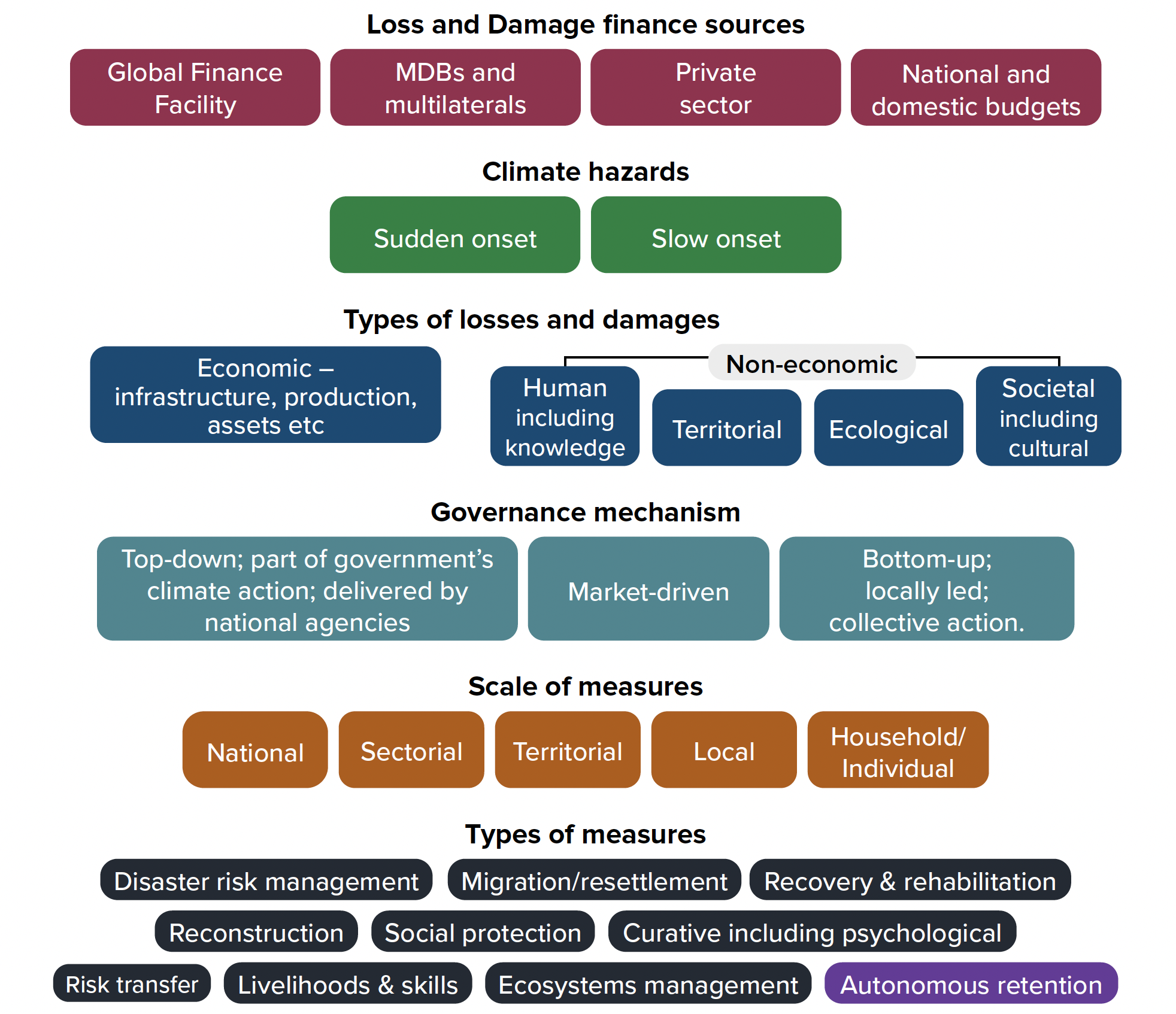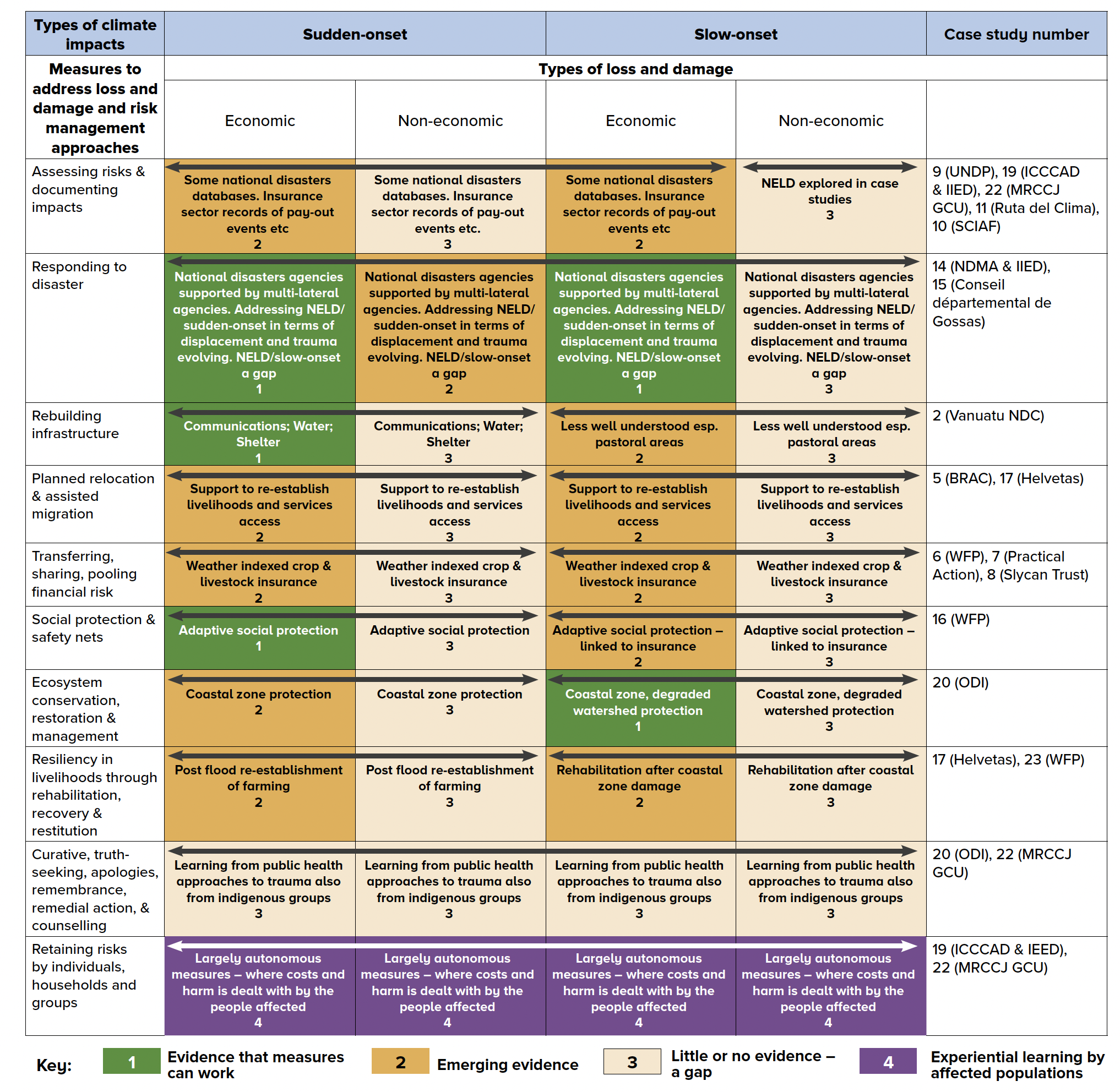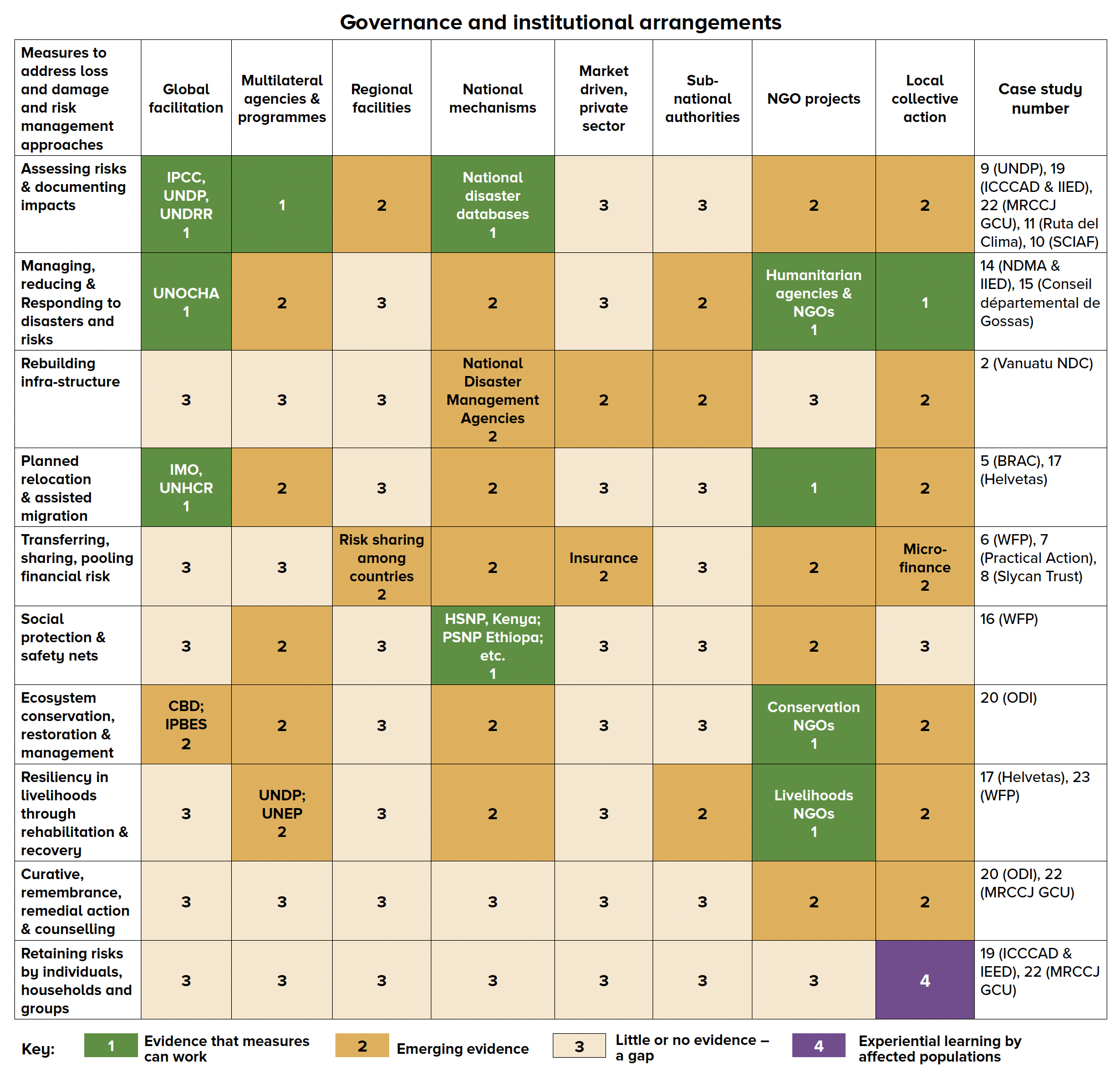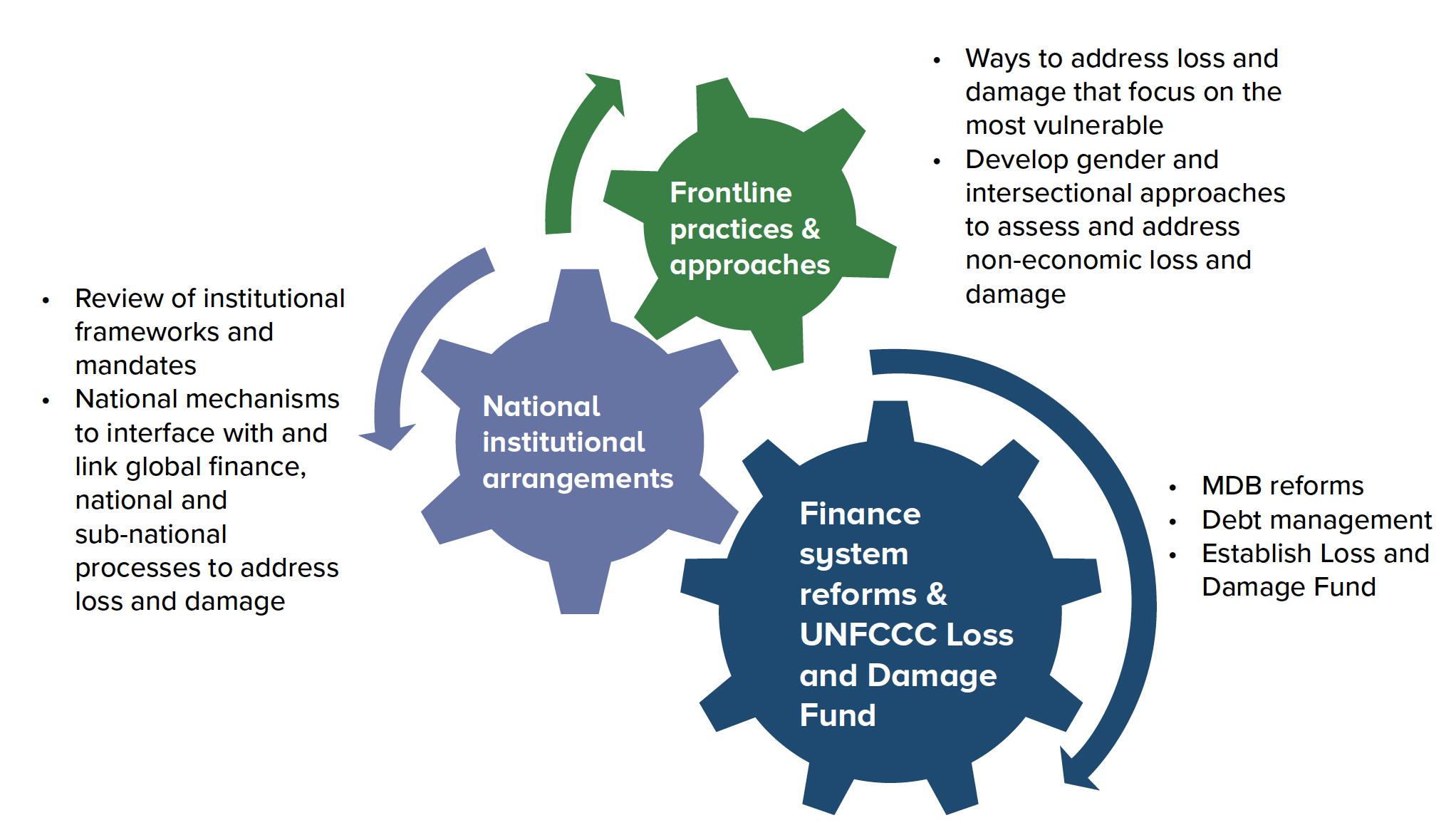Climate loss and damage: practical action
The report is a synthesis of different views and analyses of practical action for addressing climate loss and damage. It considers mobilising and innovative finance, assessing needs and delivering actions.
5 Analysis of the Loss and Damage Landscape
This section analyses the landscape of approaches and institutions being used to address loss and damage, alongside a mapping exercise to identify gaps. The analysis builds on evidence from case studies, current research and grey literature to present a typology of the different measures to address loss and damage. This evidence is directly relevant to the work of the Transitional Committee for Loss and Damage of the UNFCCC.[118]
While a diverse institutional landscape to address loss and damage is emerging, finance is the main determining factor of how this landscape is, and will be, shaped. As loss and damage is not recognised in the Rio markers system (OECD-DAC) for overseas development assistance, and no programmatic budget assessments from MDBs and others on loss and damage investments have been published, it is not possible to say with any precision what proportion of climate finance is currently being used to address loss and damage.
Analysis conducted by Climate Analytics for Oxfam estimates that by 2030, developing countries will need more than USD 400bn annually to address losses and damages.[119] This far exceeds what is currently available, and is also well above the separate USD 100bn per annum agreed under the UNFCCC for climate mitigation and adaptation in developing countries.[120]
Of the loss and damage pledges made so far (as summarised in Table 1 of Section 2.1.1), the vast majority are for investments in climate vulnerable countries. Most are for disaster risk financing and insurance, and smaller amounts have been allocated for storm warning and other preventive measures, with further small amounts going to research and civil society endeavours.
Alongside the sources of finance, five further categorisations are considered in analysing and mapping the different ways in which loss and damage is being addressed. These are visualised in Figure 3.
First, approaches emerge as a response to different types of current climate impacts and future risks. These risks are broadly categorised as being either sudden (e.g. storms and cyclones) or slow onset (e.g. droughts and sea level rise) events.
Second, as highlighted in Section 4, there are different types of losses and damages. The UNFCCC has proposed two broad types – economic and non-economic. These two categories were set by economists and do not necessarily align with the ways in which people at the frontline of climate change see and feel its impacts. A more holistic appreciation of what is meant by non-economic (or what cannot easily be traded) could include human, territorial, ecological and socio-cultural impacts.
Third, the governance system used to deliver loss and damage measures is also important. There are broadly three types: 1) top-down (i.e. government-defined and delivered by national agencies); 2) market-driven (i.e. with different degrees of regulation by government); 3) bottom-up (i.e. locally led and collective action processes). All three of these governance systems can involve multilateral and non-governmental agencies that seek to strengthen and connect actions across all three governance types listed.
Fourth, measures to address loss and damage vary across dimensions of scale (regional, national, community, household, or individual), and can also be managed at different levels by sector and coverage (e.g. focusing on the most poor as in the case of adaptive social protection). Coverage across scales is important from the perspective of ways of addressing loss and damage reaching the furthest behind and most marginalised.
The final categorisation identifies and groups the measures themselves; using information from the case studies and from a subsequent review of literature and evidence, the next subsection proposes an initial typology which fits into the final layer of Figure 3.

5.1 Towards a typology of measures to address loss and damage
In outlining a typology of measures to address loss and damage, it is not intended to set a fixed frame of reference as a classification regime or taxonomy, but to enable a systematic mapping of measures that are currently being taken forward. This mapping aims to identify for which types of loss and damage (economic and non-economic from sudden and slow onset events), there are known measures to address loss and damage, and where there is evidence that such measures can work, and in-so-doing to highlight gaps. We hope that this typology will be developed further and that the mapping presented here will help to encourage investments to significantly scale up measures and to increase recognition and prioritisation of such measures in policy frameworks.
The literature offers a number of ways to classify measures to address loss and damage. Wallimann-Helmer et al[121] classify approaches into the following groups:
a) comprehensive risk management to reduce risks of future losses and damages (in addition to mitigation and adaptation);
b) risk financing for risk transfer, sharing and pooling to support vulnerable people, enterprises and countries to manage escalating financial risks due to increasingly frequent and severe extreme weather events; and,
c) curative measures and rehabilitation from irreversible impacts due to progressive slow onset processes and sudden onset extreme events that cannot or will not be avoided. Steadman et al (2022) discuss the need for these approaches to address particularly climate-induced loss and damage to cultural heritage.
Shawoo et al.[122] provide a synopsis of measures to address loss and damage which are, as yet, largely unfunded. From this synopsis, measures addressing economic loss and damage related to sudden onset events include: compensation and other social protection measures; short- and long-term recovery and rehabilitation; rebuilding damaged infrastructure; planned relocation and assisted migration; support for rebuilding livelihoods; and, insurance and risk transfer. Approaches to address economic loss and damage due to slow onset events include: planned relocation and assisted migration; reskilling and alternative livelihoods provision; and, compensation and other social protection.
For non-economic loss and damage due to both sudden and slow onset events addressing measures include: recognition of loss and repair of damage (whether or not accompanied by financial payments); enabling access and safe visits to abandoned sites; active remembrance (e.g. through museum exhibitions, school curricula etc.); counselling and official apologies.
Steadman et al[123] identify the following ways to address climate-induced loss and damage to cultural heritage:
1. Restitution: restoring those affected to their original situation (or as close as possible) before the loss and damage occurred.
2. Rehabilitation: redressing or repairing the loss and damage through the provision of social services such as healthcare, education or legal support.
3. Satisfaction: symbolic measures to recognise loss and damage, such as truth-seeking, apologies or memorialisation.
4. Material compensation: the provision of money or other benefits in compensation for loss and damage.
5. Guarantees of non-repetition: commitments and measures to prevent similar loss and damage in the future, such as codes of conduct, training or governance reform.
Drawing on these classifications, the following typology of measures is proposed: assessing risks and documenting impacts; disaster response; rebuilding infrastructure; planned relocation and assisted migration; transferring, sharing and pooling financial risk; social protection and safety nets; ecosystem conservation, restoration and management; resiliency in livelihoods through rehabilitation, recovery and restitution; curative, truth-seeking, apologies, remembrance, remedial action and counselling. The reality is that individuals, households and local groups are dealing with the unavoided impacts and residual risks associated with loss and damage by absorbing and trying to recover using their own resources. This is referred to here as autonomous risk retention[124] and denotes the real costs and harm to those people subjected to loss and damage.
The above list of measures offers a typology of loss and damage action and this is used in the mapping that follows (see Figure 4 and 5).
5.2 Mapping the loss and damage landscape
Building on the typology of loss and damage measures discussed above, this subsection considers the availability of evidence under each group of measures in order to identify gaps. The subsection ends by mapping the measures against governance and institutional arrangements, to highlight which mechanisms are successfully being used to address loss and damage and which remain untested.
The pool of available knowledge and evidence on loss and damage extends well beyond what is currently labelled as such. The following discussion summarises some existing work within the groups of loss and damage measures and, where appropriate, connects them with transferable knowledge from other fields:
- Measures for assessing risks and documenting impacts have been tried and tested in different places (as set out in case study 9 from UNDP). The CONVERGE Natural Hazards Center at University of Colorado, Boulder, provides access to a very wide range of disaster databases.[125] The Centre for Research on the Epidemiology of Disasters manages EM-DAT, the emergency events database to serve the purposes of humanitarian action at national and international levels.[126]
- There is a large amount of professional, technical, practical and local knowledge on disaster response that is being transferred to addressing loss and damage.[127] Reliefweb[128] is a humanitarian information service provided by the United National Office for the Coordination of Humanitarian Affairs that selects, classifies, curates and delivers information relevant to responding to disasters and therefore to addressing loss and damage.
- Disaster recovery in terms of reconstruction of infrastructure, including communications, water supply, shelter, etc, are deployed on a regular basis. The Sendai Framework for Disaster Risk Reduction[129] aims to avoid and reduce risk by "building back better," through the application of appropriate building codes and standards. Under the Sendai Framework localised approaches that focus on vulnerable settlements are prioritised. There are specialist agencies in different parts of the world with the necessary expertise. Given that this measure centres on economic loss and damage and recovery finance is made available from contingencies, there are strong incentives for private sector involvement to deliver these measures. For example, Mexico has created FONDEN, a natural disasters fund, to rapidly allocate federal funds for the rehabilitation of public infrastructure affected by disasters.[130]
- There is increasing attention being paid to managed migration and planned relocation – often in relation to climate impacts. Internal displacement and cross-border migration is being managed in some cases by national authorities, delegated authorities, UN agencies and civil society groups. There are also informal mechanisms whereby people find support to migrate in search of work. Case study 5 in Section 2.2 on the CBF illustrates what can be done to support people who have migrated.
- Measures for financial risk transfer, sharing and pooling are being designed, tested and implemented in different places for different types of climate risk and for different types of assets. There are several cases where largely weather-indexed insurance is being offered to people whose assets and livelihoods are exposed to climate risks (e.g. agro-pastoralists). The case studies by WFP in Ethiopia (9, 16) and Practical Action in Nepal (7) illustrate what is being learned and how best to deploy such measures
- Adaptive social protection[131] and safety nets for people facing climate impacts have been deployed in many parts of the world. This knowledge is being used to develop measures for addressing the impacts of extreme weather events. However, as shown in the case of the Productive Safety Net Programme in Ethiopia (Case study 16), the approach used to develop climate adaptive social protection measures (technocratic and productivist, or rights-based and vulnerability focused) can determine how effective these measures could be in addressing the structural dimensions of vulnerability that contribute to people facing losses and damages.[132]
- Ecosystem management measures – now being called 'nature-based solutions' (NbS) – are being developed to reduce climate impacts and address loss and damage caused by weather-related disasters.[133] While ecosystems can help mitigate climate change (acting as carbon sinks) they can also provide protection from climate impacts e.g. mangroves protecting coastal areas from storm surges. However, losses and damages are also experienced by the ecosystems that are integral to NbS, e.g. sea level rise threatens mangrove ecosystems that are sensitive to inundation rates and salinity. So, while NbS can be part of measures to address loss and damage, strategic ecosystem integrity and conservation will be needed to sustain these ecosystem services.
- There are several examples where in response to climate impacts – causing loss and damage – measures for the rehabilitation and recovery of livelihoods have been taken. The World Bank "Unbreakable" report[134] emphasises the importance of livelihoods rehabilitation as part of recovery from shocks for the poorest as these people, "depend on fewer assets, their consumption is closer to subsistence levels, they cannot rely on savings to smooth the impacts, their health and education are at greater risk, and they may need more time to recover and reconstruct."
- An example of rehabilitation with a focus on livelihoods following climate impacts is provided by Barau et al.[135] Coastal and river erosion in Bangladesh – exacerbated by climate change – has caused households to lose farms and other land. Some people resettle on "Khas" land, marginal areas owned by the state. Rehabilitation and resettlement initiatives e.g. the Climate Victims Rehabilitation Programme and the Char Development and Settlement Project, have been established. An upscaling of rehabilitation measures such as these, put in place by the government, could provide new dwellings and land for livelihoods for climate change-induced displaced people.
Figure 4 maps available evidence from sources like those described above against types of measures to assess the knowledge status of these areas. The colour coding illustrates some key issues. Green shading indicates where evidence can be identified, orange where evidence is emerging, beige where little or no evidence has been found, and purple where what is known is based upon experiential knowledge and learning by people at the climate impacts frontline. This important local evidence and knowledge base is largely discussed in anecdotal terms by outsiders.

It is clear from Figure 4 that measures to address economic loss and damage have been further investigated. The beige columns under non-economic loss and damage – in both slow and sudden onset forms – denote the limited evidence available on measures to address non-economic losses and damages. As discussed in Section 4, the difficulties in addressing these categories of loss and damage are complicated by gendered and intersectional aspects and by socio-cultural factors. These beige shaded sub-cells in the mapping represent major gaps in theory, knowledge and action.
The beige row on addressing measures including curative, remembrance, remedial action, and counselling indicates that these ways of addressing loss and damage have not been developed other than in very specific places and circumstances.
The purple shading of row retaining risks (i.e. absorbing the total costs and harm) by individuals, households and groups is significant. It denotes that costs and harm are dealt with by the people affected with little or no external support.
A case study authored by Rachel Clissold[136] and colleagues on loss and adjustment in in the Cook Islands shows how people are experiencing, preparing for, responding to and recovering from droughts and cyclones. Disaster experience over centuries has resulted in important local knowledge and traditional coping strategies to anticipate, prepare for and adapt to extreme weather. Clissold and colleagues conclude that the Cook Islanders' tacit knowledge and endogenous spiritual and community resources offer agency, hope and resilience in the face of climate change into the future.

Figure 5 provides an initial mapping of measures in relation to the governance and institutional arrangements used to coordinate them. The evidence reviewed here from case studies and secondary information has been used to identify which governance systems, at which levels and with which institutional arrangements are currently important in delivering interventions to address loss and damage.
The mapping shows how important national mechanisms through public sector agencies will be in order to draw down finance from the UNFCCC Loss and Damage Fund once established. These agencies should be able to assess needs, design measures to address, coordinate implementation, and manage the monitoring, evaluation, reporting and learning processes. It also shows how the role of sub-national authorities needs to be enhanced to take on delegated mandates from national government and to be able to facilitate bottom-up local to national approaches to address loss and damage. Both the national and sub-national components rely on the capacity that exists to govern well a complex, vulnerability-focused and largely social process. Civil society organisations, community-based groups, and NGOs are and will be involved in fostering local collective action will be for ecosystem-based measures, achieving resiliency through livelihoods rehabilitation and curative measures. They may also act as a more direct recipient of some forms of finance mobilised outside the UNFCCC.
Figure 6 shows what work at global, national and local levels needs to be carried out in synchrony to deliver a system capable of delivering the means to address loss and damage for the most vulnerable. The global financial system needs to be reformed and the UNFCCC Loss and Damage Fund established to mobilise the scale of funding that is required to address current and future losses and damages. At the national level, reviews of the institutional frameworks and mandates for addressing loss and damage are needed. These reviews can act as precursors for the establishment of national mechanisms to interface with and link global finance, national and sub-national processes to address loss and damage. At the local climate frontline ways to address loss and damage that focus on the most vulnerable are needed. It is especially necessary to develop gender and intersectional approaches to assess and address non-economic loss and damage.

Contact
Email: alice.guinan@gov.scot
There is a problem
Thanks for your feedback